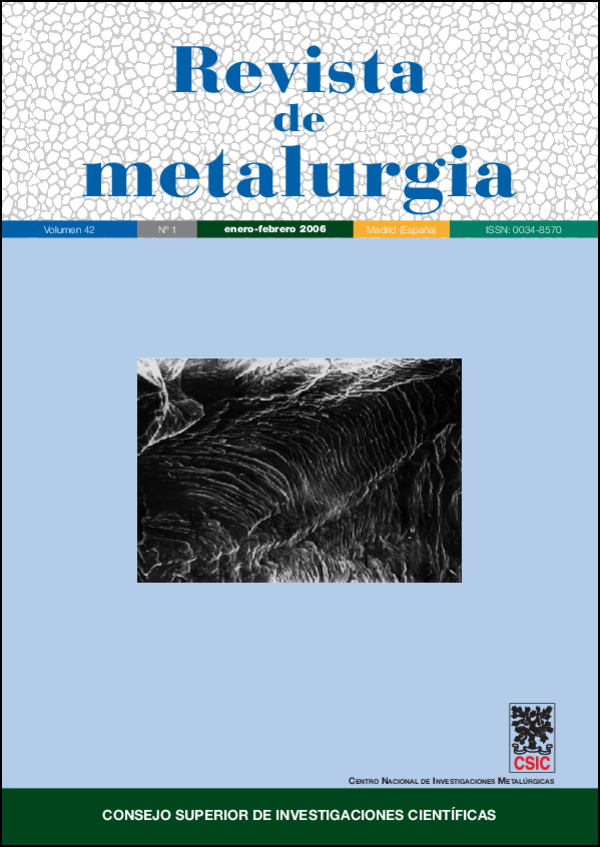Mathematical modelling of mixing in gas stirred ladles
DOI:
https://doi.org/10.3989/revmetalm.2006.v42.i1.7Keywords:
Fluid flow, Mixing, Multifluid model, Steel ladle, Gas injectionAbstract
In this work injection of air into a water physical model of an industrial steel ladle was mathematically simulated. Calculations were developed based on a multiphase Eulerian fluid flow model involving principles of conservation of mass, momentum and chemical species on both phases in order to predict turbulent flow patterns and mixing times in both centric and eccentric injections. Mixing phenomena was addressed by injecting a tracer and it was analyzed the effect of the gas flow rate, injector position, number of injectors and geometry of the ladle on the mixing time. It was concluded that the optimum injection conditions is using a single injector at 2/3 of the radius with high gas flow rates. It is shown that incrementing the number of injectors is detrimental on mixing. Finally, quantitative correlations of mixing time as a function of gas flow rate, position of the injector, number of injectors, geometry of the ladle and mass of liquid were obtained.
Downloads
References
[1] J. A. Gómez-Urquiza, Memorias del XXII Simposio Nacional de Siderurgia, vol 1, Morelia, México, 2001, A. Conejo, J. J. Barreto y J. J. Uribe (Eds.), pp. 19-1 a 19-23.
[2] F. Chávez-Alcalá, A. Cruz-Ramírez y J. Romero-Serrano, Rev. Metal. Madrid 40 (2004) 39-45.
[3] D. Mazumdar y R. I. L. Guthrie, Metall. Trans. B 17B (1986) 725-733. doi:10.1007/BF02657134
[4] H. Turkoglu y B. Farouk, ISIJ Int. 30 (1990) 961-970. doi:10.2355/isijinternational.30.961
[5] T. Stapurewicz y N. J. Themelis, Can. Metall. Q. 26 (1987) 123-128.
[7] K. Nakanishi, T. Fuji y J. Szekely, Ironmaking Steelmaking 2 (1975) 193-197.
[8] U. P. Sinha y M. J. Mcnallan, Metall. Trans.B 16B (1985) 850-853. doi:10.1007/BF02667523
[9] P. E. Anagbo, J. K. Brimacombe y A. H. Castillejos, Can. Metall. Q. 28 (1989) 323- 330.
[10] G. G. Krishna-Murthy. S. P. Mehrotra y A. Ghosh, Metall. Trans. B 19 (1988) 885- 892. doi:10.1007/BF02651412
[11] D. Mazumbar y R.I.L. Guthrie, ISIJ Int. 35 (1995) 1-20. doi:10.2355/isijinternational.35.1
[12] B. E. Launder y D. B. Spalding, Comput. Methods Appl. Mech. Eng. 3 (1974) 269-289. doi:10.1016/0045-7825(74)90029-2
[13] F. Tapia-Ortiz, Tesis de Maestría, Centro de Graduados en Metalurgia, Instituto Tecnológico de Morelia, 2002.
[14] M. Iguchi, K. Nakamura y R. Tsujino, Metall, Mat Trans, B Process Metall, Mat, Process Sci. 29B (1998) 569-575.
[15] Y. Takatsuka y M. Iguchi, ISIJ Int. 41 (2001) 124-127. doi:10.2355/isijinternational.41.124
[16] Y. Pan, D. Guo y C. Li, ISIJ Int. 34 (1994) 794-801. doi:10.2355/isijinternational.34.794
[17] D. Mazumdar y R. L. Guthrie, ISIJ Int. 33 (1993) 513-516. doi:10.2355/isijinternational.33.513
[18] S. Asai, T. Okamoto, J. C. He y I. Muchi, Trans. Iron Steel Inst. Jpn. 23 (1983) 43-50.
[19] G. G. Krishna-Murthy, S. P. Mehrotra y A. Ghosh, Metall. Trans. B 19 (1988) 839- 850. doi:10.1007/BF02651408
Downloads
Published
How to Cite
Issue
Section
License
Copyright (c) 2006 Consejo Superior de Investigaciones Científicas (CSIC)

This work is licensed under a Creative Commons Attribution 4.0 International License.
© CSIC. Manuscripts published in both the printed and online versions of this Journal are the property of Consejo Superior de Investigaciones Científicas, and quoting this source is a requirement for any partial or full reproduction.
All contents of this electronic edition, except where otherwise noted, are distributed under a “Creative Commons Attribution 4.0 International” (CC BY 4.0) License. You may read the basic information and the legal text of the license. The indication of the CC BY 4.0 License must be expressly stated in this way when necessary.
Self-archiving in repositories, personal webpages or similar, of any version other than the published by the Editor, is not allowed.
















